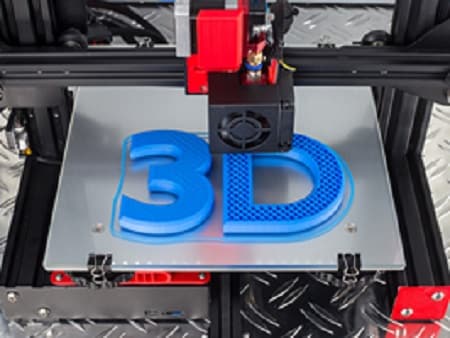Additive Manufacturing/3D Printing
Additive Manufacturing/3D Printing
- New Approaches to safe 3D printing | NIOSH | CDC – Approaches to safe 3D printing: a guide for makerspace users, schools, libraries, and small businesses
- Infographic: How to Reduce Exposures When 3D Printing with Plastic Filament
- 3D Printing with Metal Powders: Health and Safety Questions to Ask
- 3D Printing with Filaments: Health and Safety Questions to Ask
- Evaluation of 3-D Printer Emissions and Personal Exposures at a Manufacturing Workplace
Overview

Additive manufacturing technologies are rapidly expanding in use and accessibility for both businesses and consumers. As these technologies move from the laboratory to the factory floor, hospitals, schools, libraries, and home, larger numbers of people will be exposed to the technology and able to take advantage of it. These people will also be exposed to any potential hazards that additive manufacturing may pose. The National Institute for Occupational Safety and Health (NIOSH) recognizes the promise of these technologies and is performing research to understand and minimize its potential health and safety risk to the American worker, and supporting the safe and responsible deployment of this new and exciting technology.
What is additive manufacturing?
Additive manufacturing (also called 3-dimensional printing) is a set of technologies that assemble objects from smaller pieces of material. Some examples of these technologies include fused filament fabrication (may involve extruding thermoplastic filament), vat polymerization (using an ultraviolet light to cure a polymer), or powder bed fusion (melting together metal, ceramic, or plastic powder with high-power lasers or other heat sources). Once just used for prototyping, these techniques are becoming less expensive and are seeing use in production as well, affecting the automotive, aerospace, electronics, medical, and consumer markets.
What kinds of hazards are related to additive manufacturing?
Additive manufacturing hazards vary widely depending on the technology and materials used.
- Inhalation of materials used in powdered form may occur. Additionally, materials such as solvents may emit volatile organic compounds, and some processes may promote emission of volatile organic compounds (thermoplastic extrusion, vapor polishing).
- Dermal exposure to hazardous materials is possible, especially with those in powdered or liquid form.
- Some flammable or combustible liquids and powders may create a risk of fire or explosion.
- Machine support and maintenance, loading of build materials, and handling of products may create risks of mechanical or ergonomic injury and stress.
- Other hazards may be associated with specific technologies and their use environments.
What is NIOSH doing to help?
NIOSH is conducting research on safe additive manufacturing to identify knowledge gaps, to develop robust science necessary to advance understanding in the field, and to best apply these developments in order to protect the American worker.
One pillar of this effort is traditional, laboratory-based research to answer key questions and solve major problems for safe additive manufacturing. Laboratory studies have indicated that fused filament fabrication desktop printers emit respiratory irritants, that filament material and coloration significantly affected volatile organic compound emission rates, and that printing with nanomaterial containing filaments led to emission of nanomaterial containing particulate matter (Stephens et al. 2013; Stefaniak et al. 2017; Yi et al. 2019; Dunn et al. 2020).
A second pillar is the comprehensive exposure assessments have been performed by the NIOSH Nanotechnology and Advanced Materials Field Studies Team at ten different additive manufacturing sites. Fieldwork allows NIOSH to fill knowledge gaps on real-world technologies, uses, and exposures. Please reach out to us if you are interested in finding out more information or having this team visit your facility.
NIOSH continues to perform both laboratory and field studies, to determine the hazards and potential for worker exposures while using emerging technologies such as additive manufacturing.
NIOSHTIC-2 is a searchable bibliographic database of occupational safety and health publications, documents, grant reports, and journal articles supported in whole or in part by NIOSH.
NIOSHTIC-2 search results on Advanced Manufacturing.
References
Stefaniak A, LeBouf R, Yi J, Ham J, Nurkewicz T, Schwegler-Berry D, Chen B, Wells J, Duling M, Lawrence R, Martin S, Johnson A, & M. Virji M. (2017) Characterization of chemical contaminants generated by a desktop fused deposition modeling 3- dimensional Printer, Journal of Occupational and Environmental Hygiene, 14:7, 540-550, DOI:10.1080/15459624.2017.1302589
Stephens B, Azimi P, El Orch Z, & Ramos T. Ultrafine particle emissions from desktop 3D printers. (2013) Atmospheric Environment, (79) 334-339. https://doi.org/10.1016/j.atmosenv.2013.06.050
Yi J, Duling M, Bowers L, Knepp A, LeBouf R, Nurkiewicz T, Ranpara A, Luxton T, Martin S, Burns D, Peloquin D, Baumann E,Virji M, & Stefaniak A. (2019) Particle and organic vapor emissions from children’s 3_D pend and 3-D printer toys, International Forum for Respiratory Research, 31:13-14, 432-445, DOI: 10.1080/08958378.2019.1705441
Dunn KL, Dunn KH, Hammond D, & Lo S. (2020) Three-dimensional printer emissions and employee exposures to ultrafine particles during the printing of thermoplastic filaments containing carbon nanotubes or carbon nanofibers. Journal of Nanoparticle Research. 22, 46 (2020). https://doi.org/10.1007/s11051-020-4750-8
